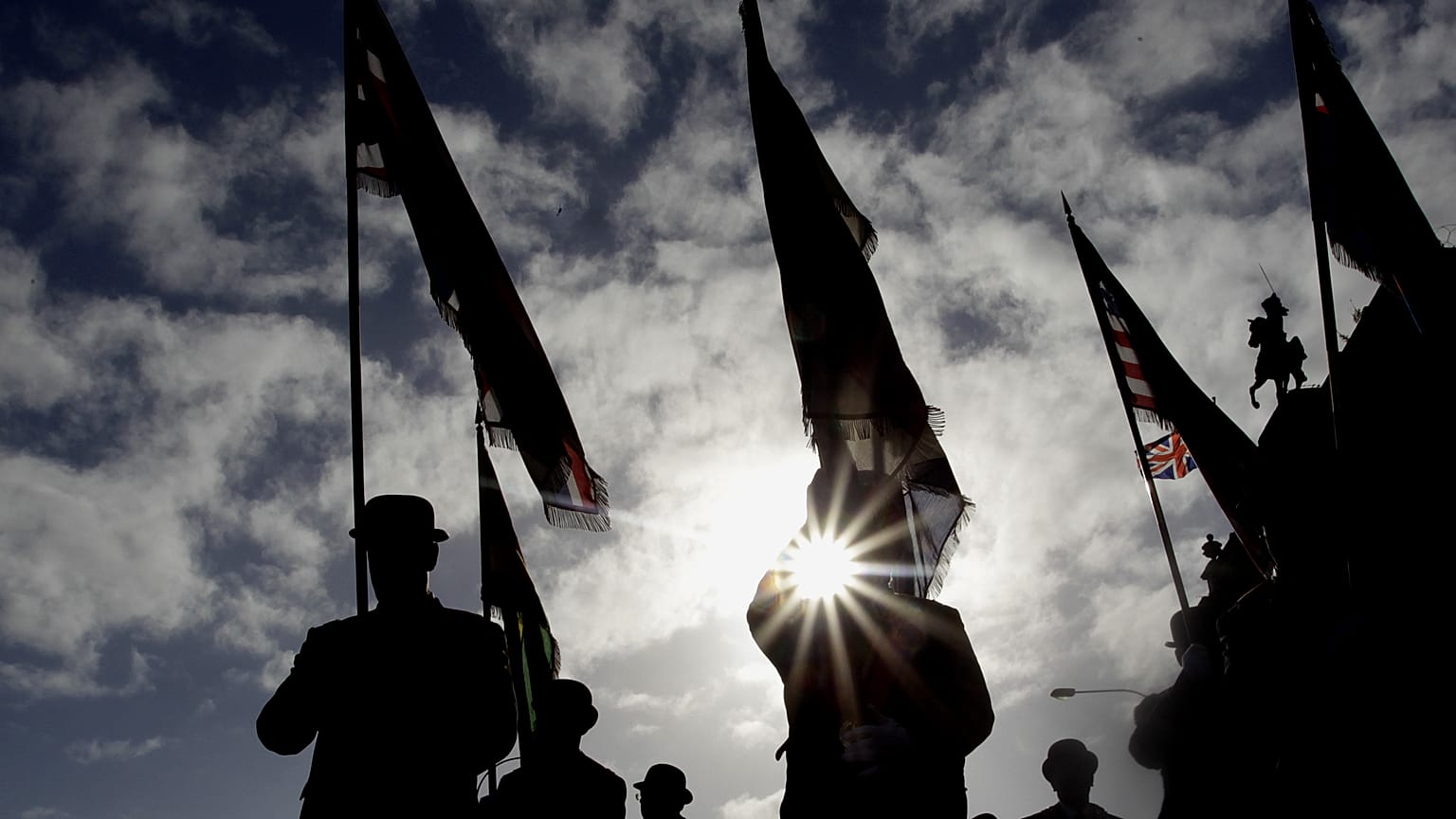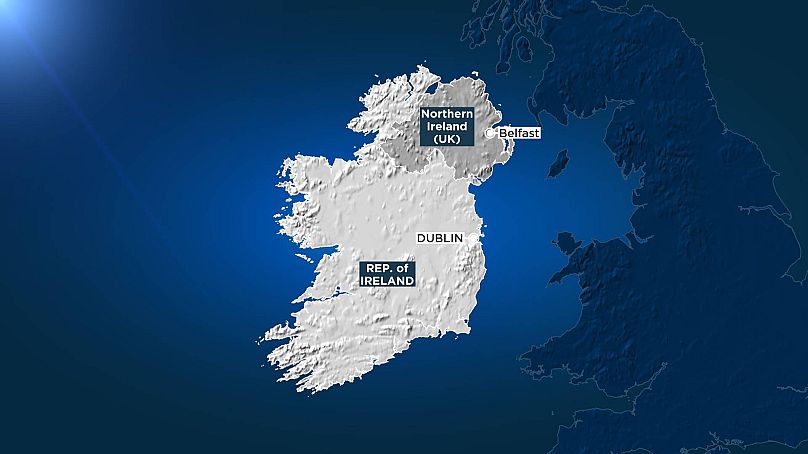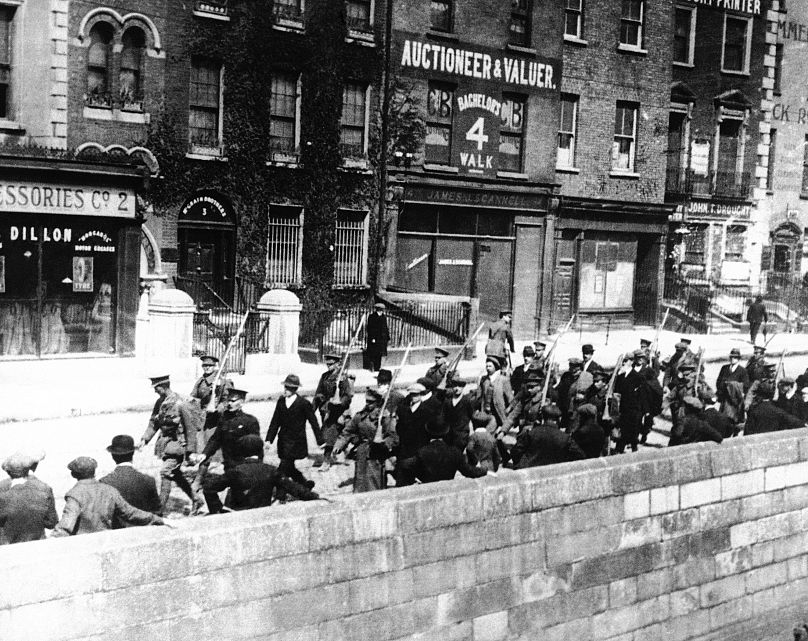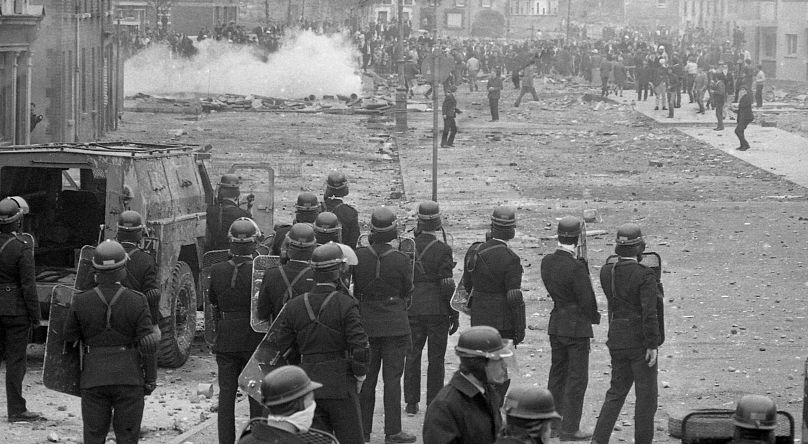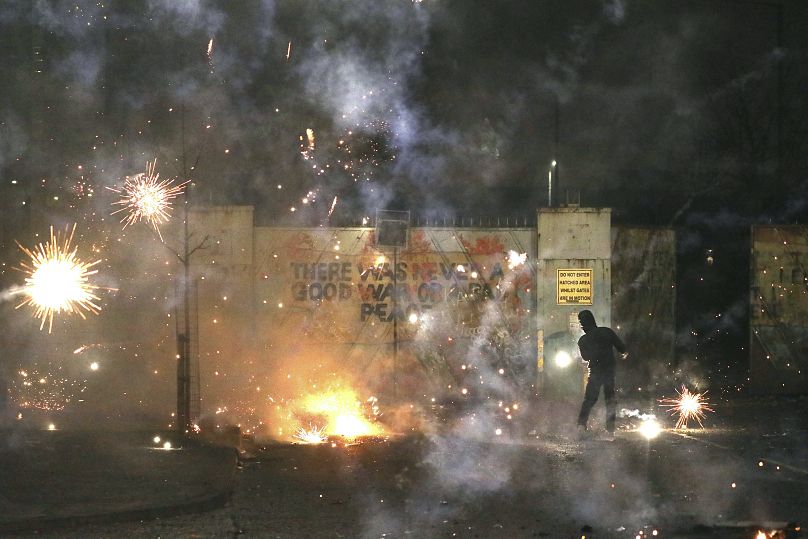On this 100th anniversary, Euronews explores the back story and enduring legacy of the partition of Ireland.
Just a hundred years ago, on May 3, 1921, Ireland was partitioned as an act passed by the British Parliament came into effect.
The 1920 Government of Ireland Act created two separate entities: Northern and Southern Ireland. The bill's original intention was to keep both under British rule but things did not quite go as planned.
26 of the island's 32 counties broke free from the United Kingdom to form an independent, Catholic-majority country which is known today as the Republic of Ireland. Six predominantly Protestant counties in the north stayed British.
A century later, Ireland is still split and the legacy of 1921 has endured.
The anniversary comes amid heightened tensions due to Brexit, as loyalists worry that so-called "Irish Sea" border checks are driving Northern Ireland away from Britain. Last month, unrest erupted in the streets of Northern Ireland, stirring memories of the Catholic-Protestant conflict that has long divided the country.
What is the back story behind the partition of Ireland and why does it still matter today?
On this 100th anniversary, Euronews looks back at the history of Ireland and how it still informs the present and future on each side of the Irish border.
What led to the partition of Ireland?
Ireland has been a contested territory since the 12th century. It was long dominated by its powerful British neighbour, ever since the Anglo-Norman invasion of 1169.
In the late 16th century, Britain implemented a plan to fully colonise Ireland in a bid to curb native Irish resistance. Thousands of Protestant settlers loyal to the British crown settled in plantations, especially in the northernmost province of Ulster.
The Irish Catholic population was displaced but did not convert to Protestantism. "Instead, two divided and antagonistic communities – each with its own culture, language, political allegiances, religious beliefs and economic histories – shared one region," wrote James Waller of Keene State College, who was a visiting research professor at the George J. Mitchell Institute for Global Peace, Justice and Security at Queen’s University in Belfast.
The conflict between the two rival communities continued to unfold in the following centuries. By the early 1900s, a nationalist, pro-independence movement emerged in the south.
"A more radical politics took over after the 1916 rebellion," said Eunan O'Halpin, professor of contemporary Irish history at Trinity College Dublin.
The bloody Irish republican insurrection began on Easter Monday, 1916 in Dublin as 1,500 Irishmen threw down an armed challenge against British rule. The rebellion was suppressed after just a week and its leaders executed.
The shift to more radical politics followed a failed attempt to implement self-government in Ireland.
"In 1914, just as World War I broke out, a law came into operation giving self-government to the entire island of Ireland, what was called Home Rule. That meant you were going to have a self-governing Ireland, but within the United Kingdom," O'Halpin explained.
Yet the idea of a self-governing province was fiercely opposed by unionists, predominantly Protestant, who feared it would be dominated by Catholics and nationalists.
After 1916, mainstream parties "almost disappeared and Sinn Féin took over," O'Halpin told Euronews. "And Sinn Féin said: 'We want an independent Republic, we don't want to be a self-governing province, we want to be an absolutely independent Republic without any connections to Britain'."
"And the problem with that from the point of view of northeast Ireland, what became Northern Ireland, they said: 'What about our identity? What about our commercial interests?'"
"And so it was inevitable that you were going to get some form of partition," O'Halpin told Euronews.
"The primary reason [behind the partition] was a marked difference between how Protestants in the northeast of Ireland felt towards the union compared to the rest of Ireland. The rest of Ireland, mainly Catholics, wanted to be independent and a sizable minority in the northeast wanted to remain within the United Kingdom. And the British government decided that the best way of resolving this issue was to partition the country," summarised Cormac Moore, a historian with the Dublin City Council and author of Birth of the Border: The Impact of Partition in Ireland.
What was in the Government of Ireland Act?
The Government of Ireland Act that entered into force on May 3, 1921 "gave two parliaments, one for Northern Ireland and one for Southern Ireland," Moore told Euronews. "Before, people thought that Ulster would just remain within Westminster, remain part of Britain and not have their own parliament," he added.
Another difference with previous Home Rule attempts is that the act created a Council of Ireland, "which would consist of 20 members from the North and the South to meet together and consult on areas of common interest," Moore said. "The objective, according to the British, was that this Council of Ireland could lead to a united Ireland, could lead to marrying the two parliaments together."
Yet the act was "only reluctantly supported by Ulster unionists. They wanted to stay within Britain, so they did not want their own parliament, but it was totally opposed by the rest of Ireland," Moore told Euronews.
"Sinn Féin had become the largest party of nationalists and wanted independence in late 1918. They didn't send MPs to Westminster and created their own parliament in 1919."
"A war began between Sinn Féin -- and its military wing, the IRA [Irish Republican Army] -- and the British in early 1919. So while the Government of Ireland Bill was going through Parliament, there was a war happening in Ireland," the historian explained.
"No nationalist was consulted on this act and most people were completely opposed to it," Moore added.
The climate of sectarian violence that dominated at the time of the partition was to continue over the following decades.
From partition to Troubles: how did the split unfold in 20th century Ireland?
"The creation of Northern Ireland essentially created a Protestant parliament for a Protestant people," Moore told Euronews. "Catholics, nationalists felt Northern Ireland was a cold house for them. There was discrimination in terms of employment, in terms of housing, etc."
"A lot of people in border counties, both Catholics and Protestants, were on the wrong side of the line," O'Halpin noted. Had the line being redrawn as it was once considered, "a lot of the difficulties would have not have been so extreme," the historian told Euronews.
After a wave of sectarian violence in the summer of 1922 that killed almost 600 people in the north, an "uneasy peace" came, Moore told Euronews. "But it wasn't permanent as the nationalist Catholic community felt that Northern Ireland was not a home for them," Moore said.
"All those issues continued for decades," becoming a "direct cause of the Troubles of the late sixties."
In the 1960s, a Catholic civil rights movement demanded an end to discriminations. According to O'Halpin, the movement was inspired by the US civil rights movement, with the Catholic middle-class demanding "equal rights" and treatment as "equal citizens".
But the movement faced harsh repression from the government and police.
The unionist government reluctantly made concessions to the civil rights movement because London asked them to, O'Halpin said, "but that meant that their whole population turned against them because they felt they were giving in to pressure."
Both Catholics and Protestants formed armed groups that escalated the violence with bombings and shootings.
The British Army was deployed in 1969, initially to maintain peace. The situation deteriorated into a conflict between Irish republican militants who wanted to unite with the south, loyalist paramilitaries who sought to keep Northern Ireland in Britain, and British troops.
More than 3,600 people, a majority of them civilians, were killed in bombings and shootings over the three decades of conflict.
The bloodshed largely ended in 1998 with the Good Friday accord that saw the paramilitaries lay down their arms and established a Catholic-Protestant power-sharing government for Northern Ireland.
The agreement did not rule out a future referendum on reunification in Northern Ireland, saying it would remain British as long as that was the majority’s wish.
Why does partition still matter today?
Last month, dozens of police officers were injured in successive nights of violence across parts of Northern Ireland, drawing comparisons to the early days of the Troubles.
The impacts of Brexit were one of the main reasons behind the rioting.
"10 years ago I thought well, the cause of the frictions have died down because we're all in the EU together," O'Halpin told Euronews.
The peace process relies on an open Irish border allowing the free flow of goods and people. But a "hard Brexit” that entered into force earlier this year meant the creation of new barriers and checks on trade.
Both the UK and the EU agreed that the border could not be in Ireland because of the risk that would pose to the Good Friday agreement.
The alternative was to put it in the Irish Sea — between Northern Ireland and the rest of the UK. That arrangement has angered British unionists who say it weakens Northern Ireland’s place in Britain.
UK Prime Minister Boris Johnson "lied saying there wouldn't be any practical consequences for Northern Ireland, that there wouldn't be a border in the Irish sea. There is a border in the Irish Sea," O'Halpin said.
"You can't be in the single market without the consequence of having goods coming from Britain to Northern Ireland being subjected to checks, because Northern Ireland is in the single market and Britain isn't, the scholar explained.
Moore told Euronews that the importance of the recent clashes should not be overstated. "I don't see huge appetite from either community for a return to violence," the historian said.
"But partition is always going to be a big issue, in part because it [Northern Ireland] is a contested entity and it has never been supported by nationalists and most Catholics."
Besides Brexit, another thing that has changed in Northern Ireland in recent years is the demographics.
"At the time of partition, protestants had two-thirds majority compared to Catholics with one third. Now Protestants and Catholics are almost at the same levels in Northern Ireland. So there definitely is a move towards people who would support a united Ireland as opposed to staying in Britain," Moore told Euronews.
What will commemorations look like?
"It's a very divisive commemoration because one community wants to celebrate their remaining within the United Kingdom and another community wants nothing to do with partition," Moore said.
"I think COVID-19 is potentially a stroke of good luck for the government of the Republic of Ireland because they're not going to do a whole lot."
O'Halpin also said the pandemic was "good news in terms of the politics of commemoration because you can't have huge parades like Mayday parades or Bastille day in Paris."
Commemorations organised by the state are "only going to cause friction, especially in Northern Ireland" where "things could escalate very quickly," O'Halpin said.
In Northern Ireland, "the two leading parties have very different viewpoints on commemorations. DUP democratic unionist party wants to celebrate partition, whereas Sinn Féin wants nothing to do with partition," Moore said.
Meanwhile, the British government will focus on peace and reconciliation. "This is a fantastic opportunity for people right across the UK to celebrate Northern Ireland and its integral place within our Union," said Northern Ireland Secretary Brandon Lewis as he outlined commemorations plans last year.
"I think they've tried to sanitise this, which to me is a bad idea," Moore said of the UK's plans to commemorate the centenary. "Partitions are by their very nature divisive, you can't ignore that."
What are the specificities of the Irish partition?
One thing that is unusual about the Irish partition is that "even though there was a political partition, there was not a social and cultural partition," Moore told Euronews, contrasting for instance with eastern and western Germany before reunification.
"So most of the religions in Ireland are all-Ireland bodies. Most sporting organisations are all-Ireland bodies, as well as trade associations and trade unions," the historian noted.
In many other respects, the partition of Ireland is not unique in western Europe.
"We shouldn't think of the Northern Ireland situation as unique, even in Western Europe, because everywhere a border has been drawn, there are people and communities who feel they're on the wrong side," O'Halpin said.
"All across Europe, there are minorities who feel bitter" about discrimination, the scholar noted. "So the Irish partition is not a unique phenomenon, it's not a moral issue but a pragmatic issue of how States should be persuaded to treat their minorities fairly."
Every weekday at 1900 CEST, Uncovering Europe brings you a European story that goes beyond the headlines. Download the Euronews app to get an alert for this and other breaking news. It's available on Apple and Android devices.















